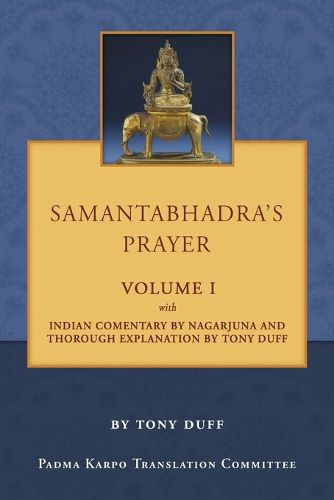Readings Newsletter
Become a Readings Member to make your shopping experience even easier.
Sign in or sign up for free!
You’re not far away from qualifying for FREE standard shipping within Australia
You’ve qualified for FREE standard shipping within Australia
The cart is loading…






This title is printed to order. This book may have been self-published. If so, we cannot guarantee the quality of the content. In the main most books will have gone through the editing process however some may not. We therefore suggest that you be aware of this before ordering this book. If in doubt check either the author or publisher’s details as we are unable to accept any returns unless they are faulty. Please contact us if you have any questions.
The Prayer of Samantabhadra, also known as a prayer of excellent conduct and also as a king of prayers is one of the five great prayers of the Great Vehicle tradition and one of the most popular prayers in that tradition. For example, it is recited every day without fail by many Tibetans. While using the prayer in Tibetan and English, the author discovered that existing English translations from Tibetan sources have many mistakes, all of which give readers a wrong understanding of what the prayer actually says. Therefore, the author undertook a major study of the sutra in order to provide practitioners with a reliable translation and a complete set of explanations that would explain correctly and in depth every facet of meaning contained of the sutra. Volume I has two commentaries, one by the Indian master Nagarjuna and one written by the author himself. It is essential to have an Indian commentary as a basis for understanding and translating the prayer because it will show the original understanding of the prayer according to the Indian tradition of Buddhism. Several such commentaries are preserved in the Tibetan Translated Treatises and the author read them all. He selected the one by Nagarjuna because it is the earliest of all the preserved Indian commentaries and also because it is particularly clear, showing points of meaning and grammar that are essential to obtaining a correct translation of the prayer. Likewise, it is essential to have a commentary written by an English-speaking expert so that all the issues related to the prayer in English translation can be clearly presented for readers. For this commentary, the author drew together material from many Indian and Tibetan commentaries then explained the prayer directly in English, paying special attention to English-related issues that are not covered in Indian or Tibetan commentaries.
$9.00 standard shipping within Australia
FREE standard shipping within Australia for orders over $100.00
Express & International shipping calculated at checkout
This title is printed to order. This book may have been self-published. If so, we cannot guarantee the quality of the content. In the main most books will have gone through the editing process however some may not. We therefore suggest that you be aware of this before ordering this book. If in doubt check either the author or publisher’s details as we are unable to accept any returns unless they are faulty. Please contact us if you have any questions.
The Prayer of Samantabhadra, also known as a prayer of excellent conduct and also as a king of prayers is one of the five great prayers of the Great Vehicle tradition and one of the most popular prayers in that tradition. For example, it is recited every day without fail by many Tibetans. While using the prayer in Tibetan and English, the author discovered that existing English translations from Tibetan sources have many mistakes, all of which give readers a wrong understanding of what the prayer actually says. Therefore, the author undertook a major study of the sutra in order to provide practitioners with a reliable translation and a complete set of explanations that would explain correctly and in depth every facet of meaning contained of the sutra. Volume I has two commentaries, one by the Indian master Nagarjuna and one written by the author himself. It is essential to have an Indian commentary as a basis for understanding and translating the prayer because it will show the original understanding of the prayer according to the Indian tradition of Buddhism. Several such commentaries are preserved in the Tibetan Translated Treatises and the author read them all. He selected the one by Nagarjuna because it is the earliest of all the preserved Indian commentaries and also because it is particularly clear, showing points of meaning and grammar that are essential to obtaining a correct translation of the prayer. Likewise, it is essential to have a commentary written by an English-speaking expert so that all the issues related to the prayer in English translation can be clearly presented for readers. For this commentary, the author drew together material from many Indian and Tibetan commentaries then explained the prayer directly in English, paying special attention to English-related issues that are not covered in Indian or Tibetan commentaries.